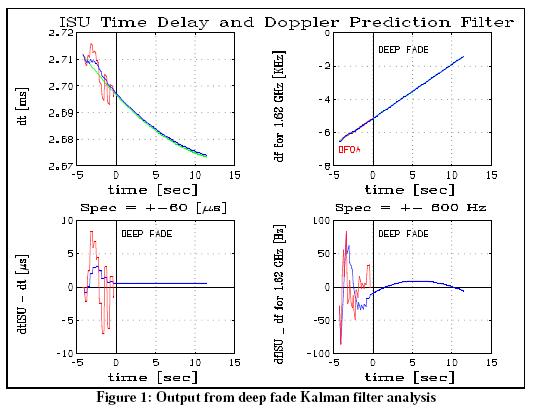Mainnavigation
Subnavigation
BORDER
Pagecontent
Deep Fade Kalman Filter Design
This example shows a SatLab plots for a design test of a Kalman filter to cope with time<br />delay and doppler during deep fade. These plots are from the period of maximum change in the rate of deep fade.
The script to generate these plots is shown below.

%demo Deep Fade Kalman Filter
%
% The requirements for handsets for GMPCS satellite systems is
% that they do not loose synchronization during short time
% deep fades. They need to include a filter to predict time
% delay and doppler during the time of a deep fade where
% synchronization signals are not received from a satellite.
% This filter needs to meet the requirements after receiving
% synchronization time delay and doppler synchronization
% data for a minimum specified time.
%
% In this demo a Kalman filter is designed and analyzed
% that easily meets the requirements to predict dt and df
% for 128 frames after receiving synchronization data from
% a satellite for 48 frames, with associated measurement
% errors. The results are for the time of maximum rate of
% change of df.
%
% The Kalman Filter also smoothes DTOA and DFOA for the ISU
% SatLab demo: Horst C. Salzwedel
help demoDeepFadeKF
% Initialization
removeAll;
clearGraphic();
clear;
% L-band frame length = 90 ms
LBframe = .090;
% L-band frequency
fLB = 1.62e9;
% time constant tau = 600 seconds
tau = 1200;
% standard deviations
rand("normal"); % set random number generator to 'normal'
rand("seed", 260342); % set seed for repeatability of results
sigdtm = 4e-6; % measurement error 4 microseconds
sigdfm = 20; % measurement error 20 Hz
sigdtr = 2e-6; % reporting error 2 microseconds
sigdfr = 9.8; % reporting error 9.8 Hz
siga = 5e-5;
sigDTOA = sigdtm + sigdtr;
sigDFOA = sigdfm + sigdfr;
% state distribution matrix
A = [0 1 0
0 0 1
0 0 -1/tau];
B = [0
0
1];
% output matrix
C = [1/cLight 0 0
0 fLB/cLight 0];
% continous to discrete conversion
[Phi, Gam] = c2d(A, B, LBframe);
Q = siga;
% initialization
loadreplaceAll("./IRsingle.data");
setSimEpoch(2002,3,26,11,58,54.91185); % 0 sec
setSimTime(0);
g = GeoPosition(3);
g = g(1:2,:);
lat0 = g(1, 1);
lon0 = g(2, 1);
setStationParameter('E1', I_earth, 0, lat0*r2d, lon0*r2d, 0);
setSimEpoch(2002,3,26,11,58,34.91185); % -20 sec
setSimTime(0);
setSimStepSize(LBframe);
% initialization of ISU
[d, r, a, e, v] = RelPosition('E1');
dfISU0 = r(2)/cLight*fLB;
dfISU = dfISU0;
dtISU0 = d(2)/cLight;
dtISU = dtISU0;
% state vector
x = [dtISU*cLight dfISU*cLight/fLB 0];
P = diag([1e1 1e-6 1e-2]);
% covariance matrix R
R = [sigDTOA^2 0
0 .8*sigDFOA^2];
% initialization of SV
j = 0;
iSV = 0;
dtsum = 0; % summer for dt averaging
dfsum = 0; % summer for df averaging
DTOA = 0; % SV time delay error measurement
DFOA = 0; % SV doppler frequency error measurement
ii = [-47:127];
for i = ii,
iSV = iSV + 1;
j = j + 1;
stepSim; % step simulation forward by 1 L-band frame
%predict time delay and doppler frequency
x = Phi*x; % Kalman Filter time update
y = C*x;
dtISU = y(1);
dfISU = y(2);
% Doppler and time delay of up/down link
[d, r, a, e, v] = RelPosition('E1');
Mdf(j) = r(2)/cLight*fLB; % store true df in array for plotting
Mdt(j) = d(2)/cLight; % store true dt in array for plotting
% measurement of dt and df by SV
dtsum = dtsum - dtISU + Mdt(j) + sigdtm*rand(1);
dfsum = dfsum - dfISU + Mdf(j) + sigdfm*rand(1);
% measurement update
if (iSV == 4)
DTOA = dtsum/4 + sigdtr*rand(1);
DFOA = dfsum/4 + sigdfr*rand(1);
dtsum = 0;
dfsum = 0;
iSV = 0;
dtISUm = DTOA;
dfISUm = DFOA;
if i < 0, % time before fade
y_m = [DTOA
DFOA]; % measurements from satellite
M = Phi*P*Phi` + Gam*Q*Gam`; % error covariance time update
K = M*C`*inv(C*M*C` + R); % Kalman filter gain
x = x + K*(y_m); % measurement update
P = M - K*C*M; % error covariance measurement
update
imeasurement = j;
endif
endif % 4th frame
MdtISU(j) = dtISU+DTOA;
MdfISU(j) = dfISU+DFOA;
% estimate y
y_e = C*x;
EdtISU(j) = y_e(1);
EdfISU(j) = y_e(2);
endfor
erase
title('ISU Time Delay and Doppler Prediction Filter')
window('221')
iim=ii(1:imeasurement);
plot(ii`*LBframe, Mdt*1e3, 'green',
iim`*LBframe, MdtISU(1:imeasurement)*1e3, 'red',
ii`*LBframe, EdtISU*1e3, 'blue', 'grid')
xlabel('time [sec]');
ylabel('dt [ms]');
wtext(1,2.645,'Deep Fade')
wtext(-4,2.622,'DTOA','red')
window('223')
plot(ii`*LBframe, (EdtISU - Mdt)*1e6, 'grid', 'blue',
iim`*LBframe, (MdtISU(1:imeasurement) - Mdt(1:imeasurement))*1e6,
'red');
xlabel('time [sec]');
ylabel('dtISU - dt (ms)',
'll ll sgls');
title(' Spec = +-60 (ms) ',
' lll sgls ')
wtext(1,8,'Deep Fade')
window('222')
plot(ii`*LBframe, Mdf/1000, 'grid', 'green',
iim`*LBframe, MdfISU(1:imeasurement)/1000, 'red',
ii`*LBframe, EdfISU/1000, 'blue');
xlabel('time [sec]');
ylabel('df for 1.62 GHz [KHz]');
wtext(1,-1,'Deep Fade')
wtext(-4,-7,'DFOA','red')
window('224')
plot(ii`*LBframe, (EdfISU - Mdf), 'grid', 'blue',
iim`*LBframe, (MdfISU(1:imeasurement) - Mdf(1:imeasurement)),
'red');
xlabel('time [sec]');
ylabel('dfISU - df for 1.62 GHz [Hz]');
title(' Spec = +- 600 Hz ',
' lll l ')
wtext(1,80,'Deep Fade')